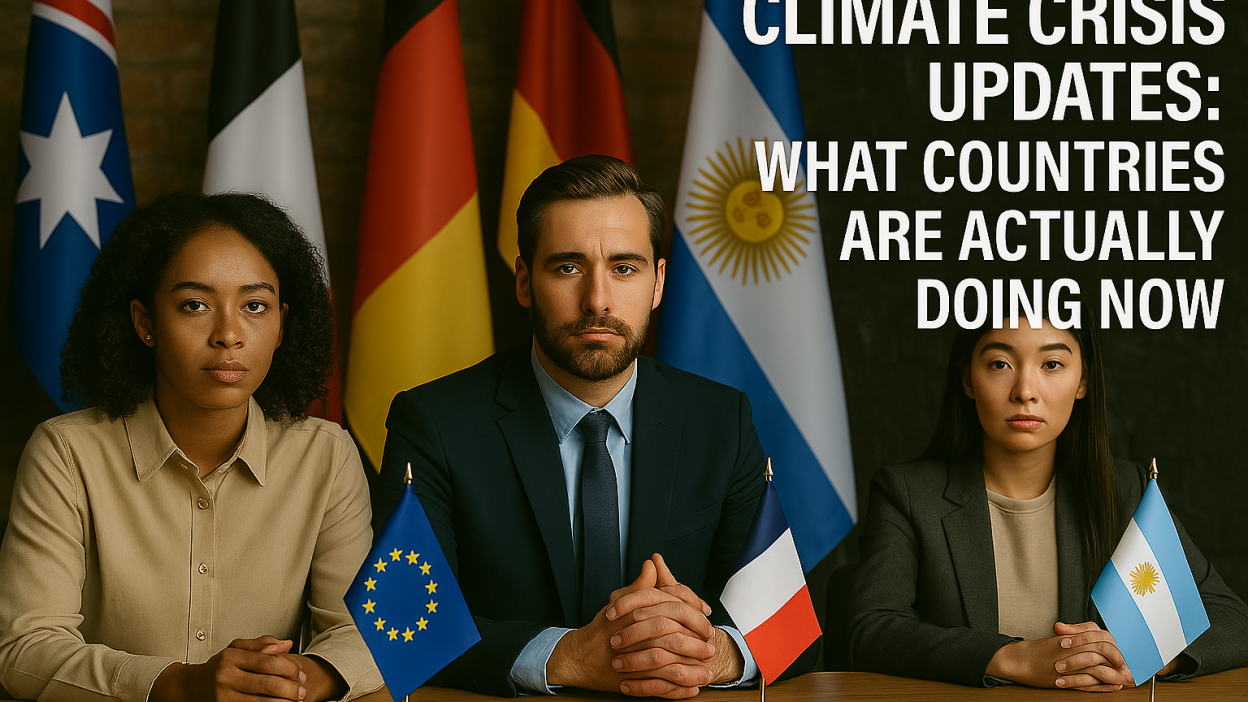The climate crisis is no longer a looming threat—it’s a daily reality. As extreme weather events, rising sea levels, and biodiversity loss intensify, the world’s response is under a global microscope. But what are countries actually doing in 2025 to combat climate change? Beyond pledges and promises, this article dives into real policies, actions, and outcomes in key regions.
🔥 Why Climate Action in 2025 Matters More Than Ever
According to the IPCC’s 2023 Synthesis Report, limiting global warming to 1.5°C requires drastic emissions reductions by 2030. The next five years are critical. Scientists have made it clear: inaction is no longer an option—and 2025 is a decisive pivot point.
🇪🇺 European Union: Leading in Regulation and Renewable Shifts
The European Green Deal continues to be the world’s most aggressive climate framework. Here’s what the EU is doing now:
- Carbon Border Adjustment Mechanism (CBAM) fully launched: Tariffs on carbon-intensive imports.
- Ban on internal combustion engines: New petrol and diesel cars will no longer be sold starting 2035, but 2025 marks a turning point in EV infrastructure.
- Fit for 55 Package: Aims to cut net greenhouse gas emissions by 55% by 2030.
- Massive wind and solar deployment: EU hit 50% renewable energy milestone in 2025.
🔍 Standout Country: Germany is closing its last coal plants by 2030, and now gets 70% of electricity from renewables.
🇺🇸 United States: Federal Push Meets Local Innovation
Thanks to the Inflation Reduction Act (IRA) and other federal policies, 2025 is a breakout year for American climate action:
- $369 billion in clean energy investments are now flowing into solar, wind, EVs, and carbon capture.
- EV tax credits are incentivizing mass adoption—EVs now make up 35% of new car sales.
- Methane regulations: Stricter rules on oil and gas leaks just came into force.
- State-level leadership: California, New York, and Washington are going beyond federal goals.
🔍 Notable Project: Texas, traditionally an oil hub, is now the #1 state for wind energy production.
🇨🇳 China: Scaling Clean Tech While Balancing Coal
China remains the world’s largest emitter but is also the largest investor in green tech:
- Renewable expansion: Over 60% of new power capacity in 2025 is solar or wind.
- Electric vehicle boom: Over 50% of new car sales in major cities are EVs.
- Coal dilemma: While clean energy grows, China is still approving some new coal plants for energy security.
🔍 Progress point: The world’s largest solar farm (16 GW) opened in Inner Mongolia this year.
🇮🇳 India: Balancing Growth with Green Goals
India’s climate efforts are accelerating with support from international funds and domestic policy:
- Target: 500 GW of non-fossil fuel energy capacity by 2030—progress in 2025 is ahead of schedule.
- Green Hydrogen Mission: India aims to become a global hub for hydrogen fuel.
- Heatwave resilience: Cities like Ahmedabad are implementing climate-adaptive infrastructure.
🔍 Innovation spotlight: India’s first 100% solar-powered airport in Kochi is inspiring global emulation.
🇧🇷 Brazil: Rainforest Protections Back in Focus
After years of setbacks, 2025 marks a resurgence of environmental leadership in Brazil:
- Amazon deforestation dropped 60% since 2023 under stricter enforcement and reforestation programs.
- Indigenous rights and forest stewardship are being prioritized in national policy.
- Green economy initiatives are linking forest protection to economic development.
🔍 Big win: The Amazon Fund is receiving record international donations to support conservation.
🌐 Global Agreements and International Cooperation
Beyond national action, 2025 also sees growth in global cooperation:
- COP30 Preparations (hosted by Brazil in 2025): Focus on climate finance and loss and damage funds.
- Global Methane Pledge: Now signed by over 150 countries.
- Climate tech transfer programs are helping developing nations adopt solar, wind, and battery technologies.
❗ Challenges That Still Persist
Despite progress, major obstacles remain:
- Climate financing gaps: Many developing countries still lack access to funds.
- Greenwashing: Some corporations and governments exaggerate climate claims without results.
- Slow fossil fuel phase-outs: Especially in high-demand nations and politically complex regions.
🌱 What Can Individuals Do in 2025?
While systemic change is vital, individual actions matter too:
- Switch to plant-rich diets
- Opt for sustainable transport (EVs, public transit, bikes)
- Support clean energy providers
- Vote for climate-conscious leaders and policies
- Reduce air travel or purchase verified carbon offsets
🧭 Final Thoughts
The climate crisis is not a future event—it’s unfolding right now. Fortunately, 2025 shows that real action is being taken. But this momentum must accelerate. Governments, businesses, and individuals all have a role to play. The path forward is clear: cut emissions, protect ecosystems, and build resilient societies.
The clock is ticking—but so is global action.





